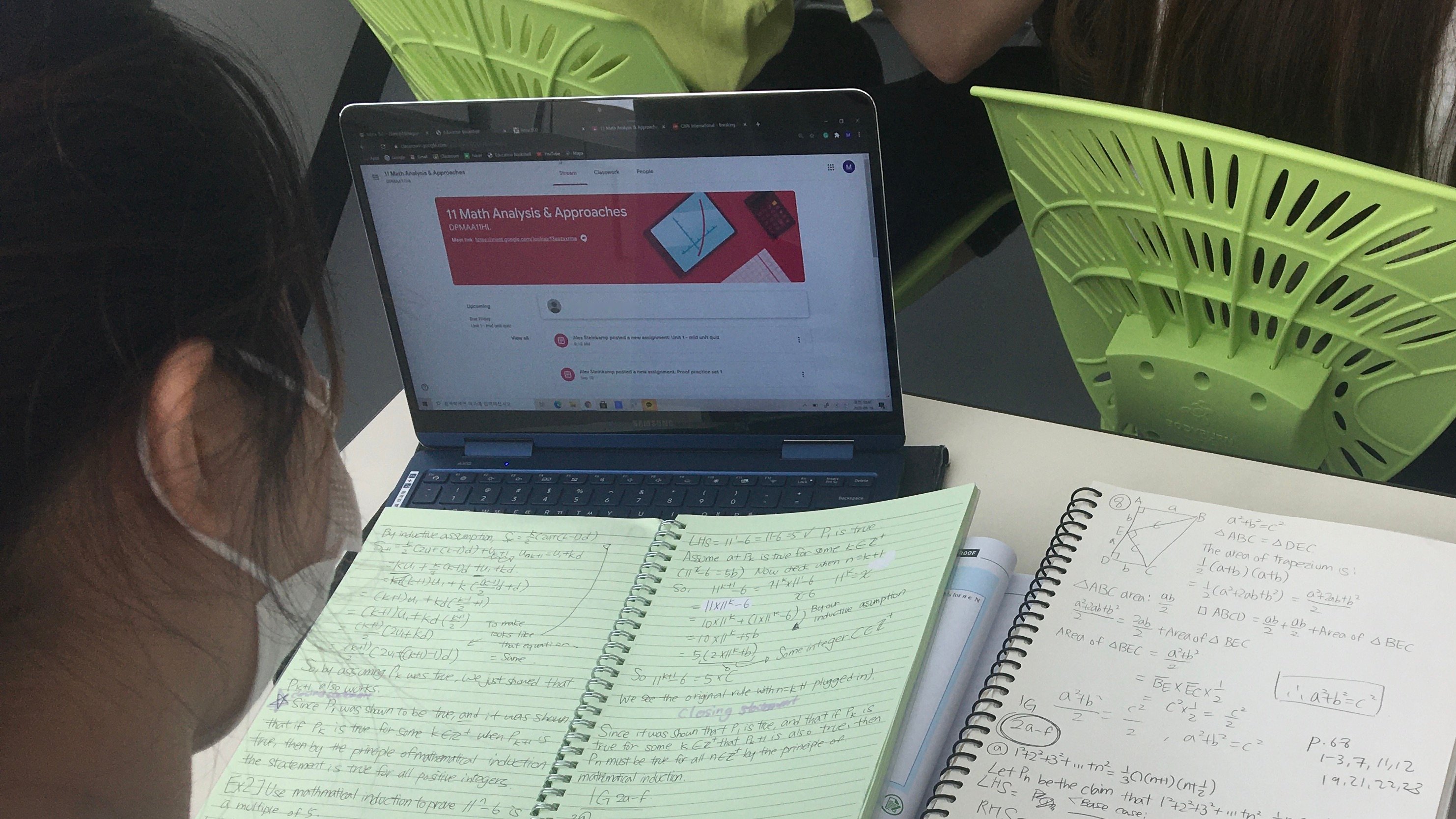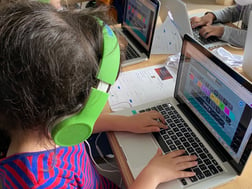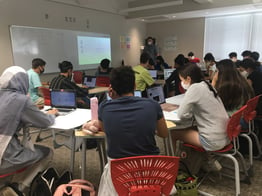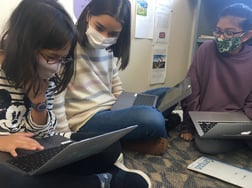 Ms. Sylvia Johnston, the Tech Coordinator at NIS, talks about all the benefits of Google Classroom, explaining them in terms of the four pillars of Create, Curate, Collaborate and Communicate and why it is the best choice as a Learning Management System for NIS.
Ms. Sylvia Johnston, the Tech Coordinator at NIS, talks about all the benefits of Google Classroom, explaining them in terms of the four pillars of Create, Curate, Collaborate and Communicate and why it is the best choice as a Learning Management System for NIS.
Create
G Suite + Google Classroom = Creativity
G Suite is used throughout the school by all members of our community, particularly students and teachers. This is the suite of tools that host Documents (Docs), Spreadsheets (Sheets), Forms, Slides, Drawing, and Sites to facilitate learning. These are outstanding creative tools that allow students to express themselves in a variety of formats. Students can select the best tool for the job from a simple word-processed document or survey to a mind map or flamboyant multimedia website. All these tools are integrated seamlessly within the Google classroom. Teachers can create engaging lessons and share them with their students in the classroom, setting permission to allow students to have their own copy of documents, perfect for providing differentiated materials and scaffolding where required.
of our community, particularly students and teachers. This is the suite of tools that host Documents (Docs), Spreadsheets (Sheets), Forms, Slides, Drawing, and Sites to facilitate learning. These are outstanding creative tools that allow students to express themselves in a variety of formats. Students can select the best tool for the job from a simple word-processed document or survey to a mind map or flamboyant multimedia website. All these tools are integrated seamlessly within the Google classroom. Teachers can create engaging lessons and share them with their students in the classroom, setting permission to allow students to have their own copy of documents, perfect for providing differentiated materials and scaffolding where required.
Curate
Google Drive + Classroom = Curation
Through Google Drive students can store, save and organize everything that they need for school in one easy to access place in the cloud. No longer are students required to carry Pen drives, hard disks, as all these files and documents are saved automatically in the Google Drive. The drive can be accessed anywhere at any time. Further to this, all files within the drive can be made available offline for those times a student doesn’t have internet access on the go.
easy to access place in the cloud. No longer are students required to carry Pen drives, hard disks, as all these files and documents are saved automatically in the Google Drive. The drive can be accessed anywhere at any time. Further to this, all files within the drive can be made available offline for those times a student doesn’t have internet access on the go.
Teachers can use both the classroom folders that are created in the Google drive and ‘Classwork’ tab in Google Classroom to share curated resources, which are organized by “Topic’ ensuring that students have all the materials that they need at their fingertips.
Collaborate
Sharing documents + Classroom = Collaboration
Collaboration is G Suites most successful feature. Students and teachers can share work with each  other, allowing teachers to pop into documents to monitor progress as required. In addition to this, students have the ability to collaborate with peers on projects and homework tasks without physically being together. Within the Google classroom there are announcements and a ‘Stream’ where you can ‘share something with your class’ or seek clarification on tasks from either classmates or teachers, allowing students and teachers to work together to create better understandings.
other, allowing teachers to pop into documents to monitor progress as required. In addition to this, students have the ability to collaborate with peers on projects and homework tasks without physically being together. Within the Google classroom there are announcements and a ‘Stream’ where you can ‘share something with your class’ or seek clarification on tasks from either classmates or teachers, allowing students and teachers to work together to create better understandings.
Communicate
In app chat, commenting, Gmail & Meets + Classroom = Communication
Throughout G Suite and Google classroom the focus is on clear communication, this is supported by use of GMail, Google Calendars, Google Meets and Hangouts. Whenever materials, assignments, or tasks are created within the Google Classroom students will receive a gmail communication and the due dates automatically the students Google Calendar, helping students with workflow. Further to this, teachers and students who have shared access to documents can leave comments at the side or suggestions within the body of the text. These can be written in real time even as the student is working on the document. For students who are working on a group project a realtime chat is embedded within each application to allow for discussion about the direction of the work. Finally, Google Meets allow students, parents and teachers to video conference. Through the classroom meets are safe secure environments where only class members can join meets.
this is supported by use of GMail, Google Calendars, Google Meets and Hangouts. Whenever materials, assignments, or tasks are created within the Google Classroom students will receive a gmail communication and the due dates automatically the students Google Calendar, helping students with workflow. Further to this, teachers and students who have shared access to documents can leave comments at the side or suggestions within the body of the text. These can be written in real time even as the student is working on the document. For students who are working on a group project a realtime chat is embedded within each application to allow for discussion about the direction of the work. Finally, Google Meets allow students, parents and teachers to video conference. Through the classroom meets are safe secure environments where only class members can join meets.
In short, with Google Classrooms and GSuite:
Students can...
- Demonstrate their understanding using multimedia
- Create interactive presentations and visuals
- Collaborate on projects with other students whilst at home
- Create surveys to elicit feedback about their work
- Develop and maintain digital notebooks
- Ask their peers and teacher question about tasks in one place, benefiting from reading other questions and answers
Teachers can...
- Make class announcements and facilitate class discussions
- Post lessons and content, scaffolding learning for each student
- Create rich, interactive learning experiences
- Collect and assess student work, whilst sharing the assessment criteria
- Provide real-time, meaningful feedback
- Manage grades
Adapted from “Google Classroom as your Digital Learning Space” OECTA Digital Learning Series, Spring 2020
Overall, the features available within Google classroom, coupled with the G Suite of apps offered the best seamless and integrated Learning Management System suitable for the needs of the NIS community, far out weighing the features available in Haiku/Powerschool Learning.


 Ms. Sylvia Johnston, the Tech Coordinator at NIS, talks about all the benefits of Google Classroom, explaining them in terms of the four pillars of Create, Curate, Collaborate and Communicate and why it is the best choice as a Learning Management System for NIS.
Ms. Sylvia Johnston, the Tech Coordinator at NIS, talks about all the benefits of Google Classroom, explaining them in terms of the four pillars of Create, Curate, Collaborate and Communicate and why it is the best choice as a Learning Management System for NIS. of our community, particularly students and teachers. This is the suite of tools that host Documents (Docs), Spreadsheets (Sheets), Forms, Slides, Drawing, and Sites to facilitate learning. These are outstanding creative tools that allow students to express themselves in a variety of formats. Students can select the best tool for the job from a simple word-processed document or survey to a mind map or flamboyant multimedia website. All these tools are integrated seamlessly within the Google classroom. Teachers can create engaging lessons and share them with their students in the classroom, setting permission to allow students to have their own copy of documents, perfect for providing differentiated materials and scaffolding where required.
of our community, particularly students and teachers. This is the suite of tools that host Documents (Docs), Spreadsheets (Sheets), Forms, Slides, Drawing, and Sites to facilitate learning. These are outstanding creative tools that allow students to express themselves in a variety of formats. Students can select the best tool for the job from a simple word-processed document or survey to a mind map or flamboyant multimedia website. All these tools are integrated seamlessly within the Google classroom. Teachers can create engaging lessons and share them with their students in the classroom, setting permission to allow students to have their own copy of documents, perfect for providing differentiated materials and scaffolding where required. easy to access place in the cloud. No longer are students required to carry Pen drives, hard disks, as all these files and documents are saved automatically in the Google Drive. The drive can be accessed anywhere at any time. Further to this, all files within the drive can be made available offline for those times a student doesn’t have internet access on the go.
easy to access place in the cloud. No longer are students required to carry Pen drives, hard disks, as all these files and documents are saved automatically in the Google Drive. The drive can be accessed anywhere at any time. Further to this, all files within the drive can be made available offline for those times a student doesn’t have internet access on the go.  other, allowing teachers to pop into documents to monitor progress as required. In addition to this, students have the ability to collaborate with peers on projects and homework tasks without physically being together. Within the Google classroom there are announcements and a ‘Stream’ where you can ‘share something with your class’ or seek clarification on tasks from either classmates or teachers, allowing students and teachers to work together to create better understandings.
other, allowing teachers to pop into documents to monitor progress as required. In addition to this, students have the ability to collaborate with peers on projects and homework tasks without physically being together. Within the Google classroom there are announcements and a ‘Stream’ where you can ‘share something with your class’ or seek clarification on tasks from either classmates or teachers, allowing students and teachers to work together to create better understandings. this is supported by use of GMail, Google Calendars, Google Meets and Hangouts. Whenever materials, assignments, or tasks are created within the Google Classroom students will receive a gmail communication and the due dates automatically the students Google Calendar, helping students with workflow. Further to this, teachers and students who have shared access to documents can leave comments at the side or suggestions within the body of the text. These can be written in real time even as the student is working on the document. For students who are working on a group project a realtime chat is embedded within each application to allow for discussion about the direction of the work. Finally, Google Meets allow students, parents and teachers to video conference. Through the classroom meets are safe secure environments where only class members can join meets.
this is supported by use of GMail, Google Calendars, Google Meets and Hangouts. Whenever materials, assignments, or tasks are created within the Google Classroom students will receive a gmail communication and the due dates automatically the students Google Calendar, helping students with workflow. Further to this, teachers and students who have shared access to documents can leave comments at the side or suggestions within the body of the text. These can be written in real time even as the student is working on the document. For students who are working on a group project a realtime chat is embedded within each application to allow for discussion about the direction of the work. Finally, Google Meets allow students, parents and teachers to video conference. Through the classroom meets are safe secure environments where only class members can join meets.